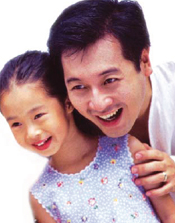By now, your preschooler would have developed a full set of baby teeth (also known as primary or deciduous teeth), which will last him until he turns eleven when the last milk tooth sheds. Good dental care at this time is critical to prevent cavities and gum disease, and make way for the development of healthy adult teeth.
THE DREADED CAVITY
Whenever your child eats something, bacteria and food particles stick to his teeth. If not removed with proper brushing, plaque will begin to form. Bacteria in the plaque digests the food and produces acid, which will dissolve the minerals that make the tooth enamel hard.
Tiny holes begin to appear on the surface of the enamel. These tiny holes become bigger and bigger until one large hole appears – this is a cavity (also known as early childhood caries). Pain ensues when the erosion goes past the enamel and attacks the dentin. Tooth decay can also lead to inability to eat, infection and fever. If the decayed tooth is extracted, it may lead the remaining baby teeth to “move across” and restrict space for adult teeth to grow. On the other hand, infection from a milk tooth that causes frequent gum abcesses may effect the developing permanent tooth underneath it. Also, once your child has had a cavity, he is at risk of developing more.
GUMS GONE BAD
While a cavity affects the tooth, periodontal disease (gum disease) is a serious bacterial infection that destroys the gums and bone around the roots of the tooth causing the tooth to become loose. You may think that periodontal disease is an adult problem, but it can occur in children in the form of gingivitis (the first stage of periodontal disease), which causes gum tissue to swell, turn red and bleed. If not treated, it will advance to more serious forms of periodontal disease. Gingivitis is almost always the result of poor dental habits. Other causes include nutrient deficiency, particularly vitamin C and certain blood disorders.
3 Steps To Healthy Teeth & Gums
Brush up!
Supervise your child’s brushing daily, before breakfast and before bedtime. (Occasionally brush their teeth for them to ensure effective cleansing)
Eat & drink right
Give your child a varied diet that emphasises foods rich in protein, vitamins, and minerals (especially calcium and phosphorous). Keep sugary snacks (especially the sticky ones) to a minimum and limit the amount of juice your child drinks each day.
Visit the dentist
Schedule a dental examination for your child twice a year even when their teeth are “healthy”. Never terrify your child with horror stories of “Mr Evil the Dentist”.
| Toothbrush & Toothpaste For Your Child |
|
Buy a children’s toothbrush specially designed for children. Because your preschooler is young, his teeth and gums are tender and sensitive. Children’s toothbrushes are specially made with bristles that are soft on teeth and gums. They are also smaller in size and therefore more appropriate for children. Attractively designed and comfortable, they make brushing fun! And if your child enjoys brushing, it will become a lifelong habit. According to the American Dental Association (ADA), research has shown that optimal levels of fluoride can reduce cavities and even repair the early stages of tooth decay before the decay is visible. Because adult toothpastes contain too much fluoride, it is recommended that you buy children’s toothpaste for your child as these contain an appropriate amount of fluoride. Use a pea-sized amount each time and make sure your child spits out the toothpaste after brushing and rinses well. |






Comments